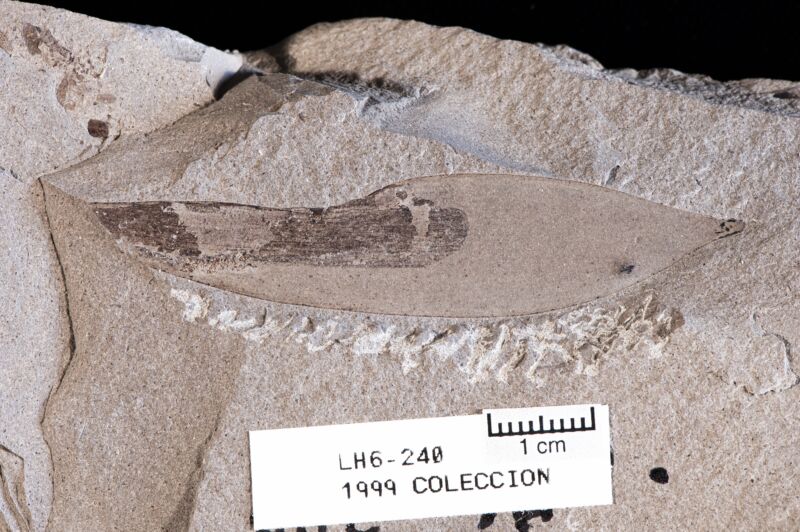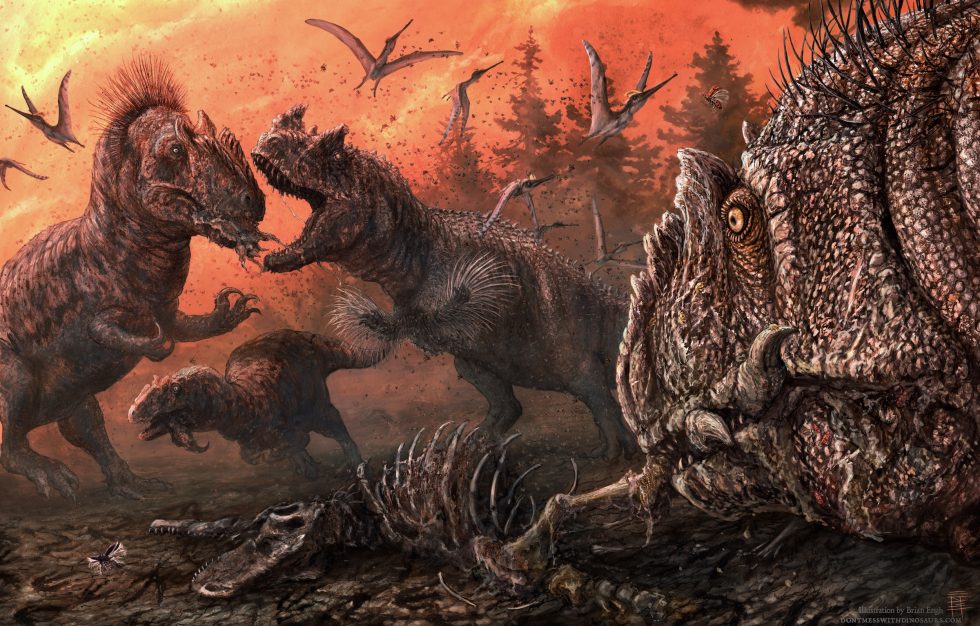Itching for ichnofossils —
“One animal could have made thousands of traces during its lifetime, but only left one skeleton.”
Jeanne Timmons
–

Enlarge / It may not look like much, but you can actually learn a lot from a fossilized leaf that preserves insect damage.
He knew what it was as soon as he saw it: the signature sign of a bird landing. He’d seen hundreds of such tracks along the Georgia coast. He’d photographed them, measured them, and drawn them. The difference here? This landing track was approximately 105 million years old.
Dr. Anthony Martin, a popular professor at Emory University, recognized that landing track in Australia in the early 2000s when he passed by a fossil slab in a museum. “Because my eyes had been trained for so long from the Georgia coast seeing those kinds of patterns, that’s how I noticed them,” he said. “Because it literally was out of the corner of my eye. I was walking by the slab, I glanced at it, and then these three-toed impressions popped out at me.”
Impressions of toes may seem to be pretty dull compared to a fully reconstructed skeleton. But many of us yearn for a window into ancient worlds, to actually see how long-extinct creatures looked, lived, and behaved. Paleontology lets us crack open that window; using fossilized remains, scientists glean information about growth rates, diet, diseases, and where species roamed. But there’s a lesser-known branch of paleontology that fully opens the window by exploring what the extinct animals actually did.
‘Fossil’ may conjure a mental image of a million-year-old bone, but it can also mean traces of behavior that survived the fossilization process: anything from the swipe of a tail as it drags across the ground and bite marks to fossil poop and vomit. ‘Ichnology’ is the name of that particular branch of study, and ‘ichnofossils’ are the traces left in the fossil record, like the bird tracks Martin recognized.
When you think of how often and how many ways anything can leave its mark on an environment, and then consider how many of those traces may have survived after millions of years, the likelihood of finding a vast variety of ichnofossils throughout the globe seems a distinct possibility.
To put it another way, Martin wrote: “One animal could have made thousands of traces during its lifetime, but only left one skeleton, parts of which may or may not be preserved.” The chances of finding ichnofossils are infinitely greater.
So why does this matter?
Trace fossils offer clues into what ancient species may have been doing, in what circumstances, and, in some cases, how they interacted with other species. A set of footprints, for example, can tell us whether an animal was walking, running, or swimming, as well as something about the environment that captured those footprints. Bite marks can offer clues into ancient diets. And some traces reveal previously unknown interactions between multiple species.
Tracks in the sand
These sorts of interactions have been discovered repeatedly within White Sands National Park in New Mexico. The site may be known more for its gorgeous white gypsum dunes, but to those interested in paleontology, White Sands is an ichnofossil treasure trove. Thousands of fossil footprints have been found here, many of them in extended tracks that cross great distances. Thanks to the record these footprints preserve, paleontologists now know that an ancient lake was once visited by Columbian mammoths, Harlan ground sloths, saber-toothed cats, dire wolves, bison, camels, and ancient humans.
David Bustos, resource program manager at White Sands who has been working there for 15 years, explained that they often find sloth and mammoth tracks near human tracks. But whereas the mammoths seem to walk on without stopping, the giant ground sloth tracks show signs of reacting: this enormous beast, estimated to weigh up to a ton, consistently turns around and then walks in another direction from the human footprints. Remarkable, but what does that mean? What was it about a human presence that seemed to influence giant ground sloths but not mammoths?
A clue can be found in a specific set of tracks in another place in the park. In these tracks, we can see ancient humans following in the footprints of a giant ground sloth, culminating at a point where the human tracks surround the sloth, which reared up on two legs.

Enlarge / Fossilized human footprints at White Sands.
One particular set of human tracks tells an intriguing story, with more unanswered questions. Based on the size of the footprints, the distance between them, and how the footprints were formed, scientists can estimate how fast that human may have been traveling. And the tracks revealed something bones could not: the human was carrying another, smaller human. At some point in the journey, the footprints stopped—a smaller set of prints found facing them, just as a young human carrying its sibling might do if that sibling were getting just a little too heavy or if adjustments were needed to clothing. Those little footprints disappeared soon after, the single set of tracks continue, their formation similar to those made when a human is carrying extra weight. The journey was in haste, the footprints slipping in ancient mud.
A set of single human tracks on the return journey no longer indicate any extra weight. The smaller human wasn’t carried on the way back, and there are no longer any smaller footprints.
Perhaps even more intriguing: this human trackway intersects with two types of Pleistocene megafauna—a giant ground sloth and perhaps three mammoths. Because the human footprints step into mammoth tracks on their journey north, and then a mammoth steps onto the human tracks after that human returns walking south, scientists know that these tracks were contemporaneous. In other words, they were made hours, maybe days after each other. And that’s astounding.
Bustos and an international team of researchers continue to explore the approximately 80,000 acres of the park. The size of the park, the relatively recent intense study of the fossils, and the increasing number of revelations in resulting papers hint that there is much yet to be discovered.
Migration, by the gut
Even without footprints, however, ichnofossils can offer clues into the paths traveled by ancient animals. Scientists used a specific type of rock to trace the possible route of sauropods—gigantic long-necked dinosaurs—in Wyoming. These weren’t just any rocks; they were smooth, polished, round, and of a distinctly different kind of mineral than anything else in the area. All of those features indicated that these rocks were gastroliths: rocks ingested to help with the animal’s digestion.

Enlarge / Stones that once resided in the digestive tract of giant sauropods.
Joshua Malone
There were no fossils found in association with any of these gastroliths. So how could we determine which species ingested them, let alone uncover the 1,000 kilometer path traveled by that species?
The relatively large size of these gastroliths indicated they could only have been swallowed by large animals. Of the fossils discovered to date in the same geological formation, a small percentage have been found with gastroliths, all either long-necked sauropods or the bipedal carnivore Allosaurus. Of the two, sauropod fossils are more abundant and are more likely to have them.
The smooth, rounded rocks, found by Joshua Malone, (a PhD student at the University of Texas at Austin), his dad, and his other co-authors, were red quartzite—a type of rock not found in the area and not known from that layer of sediment. They used detrital zircon geochronology, an innovative but destructive analysis that helped them determine the source of these gastroliths and found that one possibility was in southern Wisconsin—right at the base of an ancient stream that led back to Wyoming during the Jurassic.

Enlarge / Bighorn Basin, part of the geologic formation where the gastroliths were found.
Joshua Malone
Building upon other research, including possible sauropod migration, the authors suggest that these enormous animals ingested the red quartzite in Wisconsin as part of a potential seasonal migration route along the river. That the gastroliths are found without fossils suggests the bones didn’t survive fossilization when these animals eventually died.
Mass death
Lack of fossils was not a problem facing the researchers of the Mygatt-Moore Quarry in Colorado. An enormous amount of work went into an equally enormous amount of fossils from this site, part of the same Morrison Formation that produced the gastroliths. Paleontologists studied 2,368 fossils to determine what occurred at this mass-death assemblage, filled with the remains of sauropods and bipedal carnivorous theropods.
What they discovered was carnage and its aftermath.
Of the fossils studied, 684 had at least one, and sometimes multiple, theropod bite marks. Remarkably, given that the teeth are often the most terrifying part of any theropod, relatively few theropod bite marks have been described. Whether this is a true reflection of the fossil record or a case of underreporting is unclear. Studying the size and striation of the tooth marks, scientists could estimate the size and the species of the dinosaur that left those marks: most of them were made by either Allosaurus or Ceratosaurus. One set of marks, however, was even larger. Although no bone fossils of this frightening theropod remain at the site, ichnofossils suggest that either Saurophaganax or Torvosaurus were also among the dinosaurs feeding at that time.

Enlarge / With food scarce, carnivorous dinosaurs resorted to cannibalism.
A foot may be less inviting as a meal than a large, meaty stomach. If an Allosaurus had successfully killed a sauropod, chances are it would head straight for the area containing the viscera rather than some of its less-meaty parts. The authors found that the sauropod fossils provided evidence of this type of feeding based on the location of the bite marks.
But in theropod fossils, bite marks indicated the reverse: most of the ichnofossils were found on what might be considered less meaty, less nutritionally attractive bones such as toes. These weren’t accidents, either; examples from extinct and current predators when fighting amongst each other show that they tend to attack the head, the tail or hip, and knee joints. Moreover, if bites were made in a struggle, there would be signs of healing. No such evidence of healing was found, and the bite marks were found in areas of the body too deep to be made during squabbles.
In short, the authors found evidence of cannibalism: theropods feasting on their own kind. Though “feasting” is an overstatement; the fact that the bites occur in meat-poor body parts suggests that food may have been scarce.
“Either we have really missed this part of theropod behavior,” expressed the co-author and curator of paleontology for the Museums of Western Colorado, Julia McHugh, “or Mygatt-Moore was just a TERRIBLE place to be in the Jurassic!”

Enlarge / Undergraduate researchers helped digitize bite mark data.
Image Courtesy of the Museums of Western Colorado
Paleoartist Brian Engh, who did the artwork for these papers, remarked, “To me, it’s fascinating to think that dinosaurs were roaming that area for millions of years… but we only have record of them when something unusual happened and they all collected near that water source and many died. Then—and only then—a whole different group of ecological players leave their marks in the fossil record, as insects and scavengers worked over the carcasses.”

